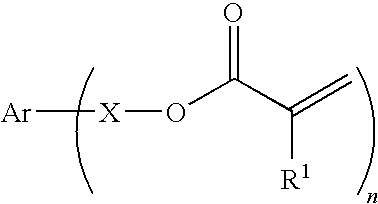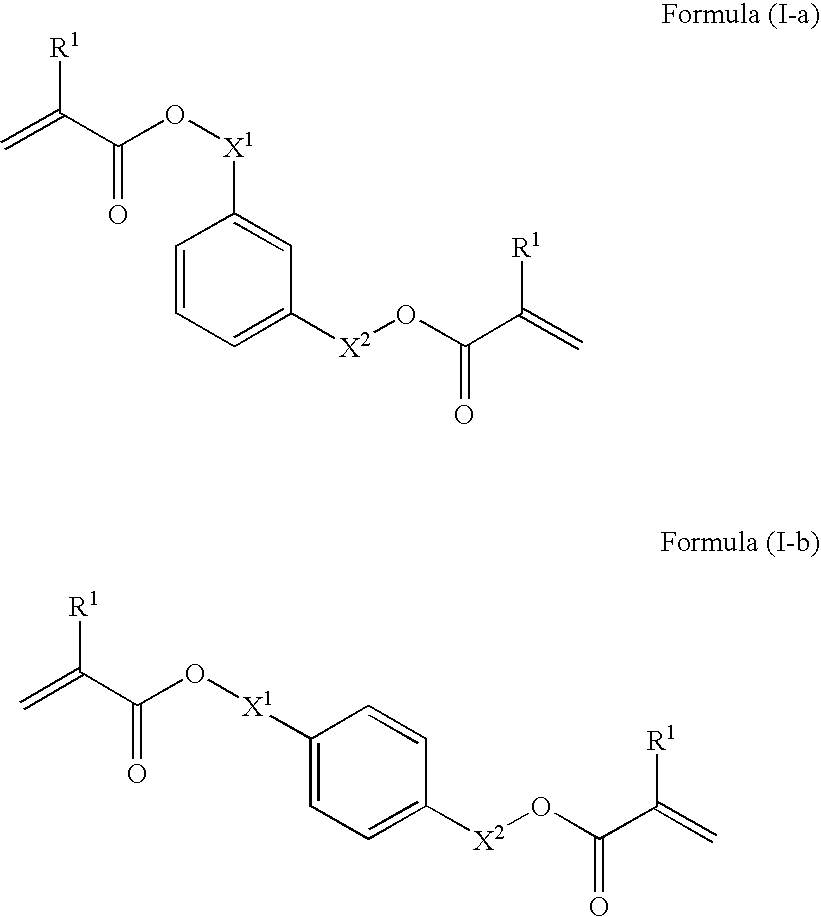Curable composition for imprints, patterning method and pattern
a composition and composition technology, applied in the field of curable composition for imprints, can solve the problems of so-called magnetic field expansion, cost reduction and throughput increase, and difficult to satisfy all the three of micropattern resolution, and achieve the effects of enhancing mold resistance releasability, enhancing the flowability of curable composition, and hardly worsening mold transferability
- Summary
- Abstract
- Description
- Claims
- Application Information
AI Technical Summary
Benefits of technology
Problems solved by technology
Method used
Image
Examples
synthesis example 1
(Synthesis of Polymerizable Monomer I-1)
[0168]39.6 g of acrylic acid was dissolved in 80 ml of distilled water, and a solution of 22 g of sodium hydroxide dissolved in 80 ml of distilled water was slowly added thereto. To this solution were added 0.04 g of 4-methoxyphenol, 7.8 g of benzyltributyl ammonium chloride, and 43.8 g of m-xylylene dichloride, and the mixture was reacted at 80° C. for 10 hours. The reaction solution was extracted from ethyl acetate, and the organic phase was washed with an aqueous 1% sodium hydroxide solution, water, and saturated saline water. The organic phase was dried with anhydrous sodium sulfate, and then concentrated to give a crude product. This was purified through column chromatography to give 48 g of a polymerizable monomer I-1. The polymerizable monomer I-1 was liquid at 25° C., and had a viscosity at 25° C. of 10 mPa·s.
synthesis example 2
(Synthesis of Polymerizable Monomer I-2)
[0169]8.2 g of acrylic acid was dissolved in 150 ml of acetonitrile, and 15.8 g of potassium carbonate was added thereto. To this was added 20 g of p-xylylene dibromide, and the mixture was reacted at 60° C. for 5 hours. The reaction solution was poured into 1000 ml of water, and the precipitated powder was collected by filtration, washed with water, and dried to give 14 g of a polymerizable monomer I-2. The polymerizable monomer I-2 was solid at 25° C., and had a melting point of 59° C.
synthesis example 3
(Synthesis of Polymerizable Compound I-3)
[0170]10 g of 4-hydroxybenzylalcohol was dissolved in 100 ml of acetone, and 21.2 g of triethylamine was added thereto. Under ice-cooling, 17.5 g of acrylic acid chloride was added thereto over 30 minutes. The mixture was reacted at room temperature for 10 hours, and then 300 ml of water was added thereto. This was extracted from ethyl acetate, and the organic phase was washed with an aqueous 1% sodium hydroxide solution, water, and saturated saline water. The organic phase was dried with anhydrous sodium sulfate, and concentrated to give a crude product. This was purified through column chromatography to give 14 g of a polymerizable monomer I-3. The polymerizable monomer I-3 was liquid at 25° C., and had a viscosity at 25° C. of 15 mPa·s.
PUM
| Property | Measurement | Unit |
|---|---|---|
| viscosity | aaaaa | aaaaa |
| viscosity | aaaaa | aaaaa |
| thickness | aaaaa | aaaaa |
Abstract
Description
Claims
Application Information
 Login to View More
Login to View More - R&D
- Intellectual Property
- Life Sciences
- Materials
- Tech Scout
- Unparalleled Data Quality
- Higher Quality Content
- 60% Fewer Hallucinations
Browse by: Latest US Patents, China's latest patents, Technical Efficacy Thesaurus, Application Domain, Technology Topic, Popular Technical Reports.
© 2025 PatSnap. All rights reserved.Legal|Privacy policy|Modern Slavery Act Transparency Statement|Sitemap|About US| Contact US: help@patsnap.com



